Elvis A. Presley - Biography
1935 - 1957
April 25, 1912
Gladys Love Smith is born.
April 10, 1916
Vernon Elvis Presley is born.
June, 1933
Gladys Smith and Vernon Presley are married.
January 8, 1935
In Tupelo, Mississippi, shortly before dawn, in a two-room house built by
her husband and her brother-in-law, Gladys Presley gives birth to identical twin
sons. The first, Jessie Garon, is born dead. The second, Elvis Aaron, is born
alive and healthy. Elvis would be their only child.
 1935 - 1948
1935 - 1948
Elvis grows up within a close-knit, working class family, consisting of his
parents, grandparents, aunts, uncles, and cousins, who all live near one another
in Tupelo. There is little money, but Vernon and Gladys do their best to provide
for their son, who is the center of their lives. They move from one house to
another in Tupelo. Elvis attends the Assembly of God Church with his family, and
the music and preaching register deeply. Other influences are black bluesmen in
the neighborhood and country music radio programs enjoyed by his family.
1945
Ten-year-old Elvis stands on a chair at a microphone and sings "Old Shep"
in a youth talent contest at the Mississippi-Alabama Fair and Dairy Show, held
in Tupelo. The talent show is broadcast over WELO Radio. Second prize is $5.00
and free admission to all the rides at the fair.
1946
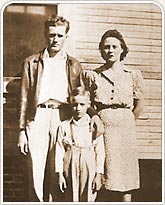 Elvis’
parents cannot afford a bicycle that Elvis wants, so Gladys talks him into
accepting a guitar instead. Elvis' first guitar costs $12.95 and is purchased at
the Tupelo Hardware Company. The bicycle would have to wait until Christmas of
1947.
Elvis’
parents cannot afford a bicycle that Elvis wants, so Gladys talks him into
accepting a guitar instead. Elvis' first guitar costs $12.95 and is purchased at
the Tupelo Hardware Company. The bicycle would have to wait until Christmas of
1947.
Late 1948
Elvis plays his guitar and sings "Leaf on a Tree" for his Milam Junior High
class in Tupelo as a farewell. Elvis and his parents pack their belongings in a
trunk strapped to the roof of their 1939 Plymouth and move to Memphis, Tennessee
in search of a better life economically. Other members of the Presley and Smith
clan would follow.
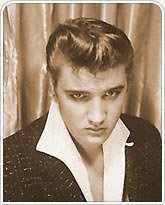 1948-1953
1948-1953
Elvis and his parents live in public housing or low rent homes in the poor
neighborhoods of north Memphis. Life continues to be hard. Vernon and Gladys go
from job to job, and Elvis attends The Christine School, then L.C. Humes High
School. Elvis works at various jobs to help support himself and his parents. The
Presley-Smith clan remains close-knit, and Elvis and his family attend the
Assembly of God Church. The teenage Elvis continues to be known for singing with
his guitar. He buys his clothes on Beale Street and he absorbs the black blues
and gospel he hears there. He’s also a regular audience member at the all-night
white, and black, gospel sings that are held downtown. He wears his hair long
(compared to the day’s standards) and slick, and lets his sideburns grow. He’s
really different from the other kids, a good-natured misfit.
While at Humes High, Elvis nervously sings with his guitar
at a student talent show. Much to his own amazement, he gets more applause than
anyone else and wins, then performs an encore. The acceptance feels good.
1935 - 1957
June 3, 1953
Elvis graduates from Humes High School.
1953
Elvis works at Parker Machinists Shop right after graduation. That summer
he drops by The Memphis Recording Service, home of the Sun label and makes a
demo acetate of "My Happiness" and "That’s When Your Heartaches Begin" for a
cost of about $4.00. (The studio came to be known as Sun Studio though never
officially named that until many years later. For simplicity this text uses the
name Sun Studio.) The studio owner isn’t in, so his assistant, Marion Keisker
handles the session. Elvis wants to see what his voice sounds like on a record
and he has aspirations to become a professional singer. He takes the acetate
home, and reportedly gives it to his mother as a much-belated extra birthday
present. By the fall, he is working at Precision Tool Company, and soon changes
jobs again, going to work for Crown Electric Company. At Crown, he does various
jobs, including driving a delivery truck. He also goes to night school and
studies to be an electrician.
January, 1954
Elvis makes another demo acetate at Sun. Sam Phillips, the owner, is in
this time and, like Marion Keisker, is intrigued by this unusual looking and
sounding young man.
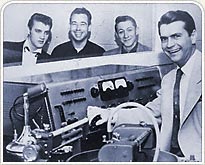 Summer 1954
Summer 1954
At Marion Keisker’s suggestion, Sam Phillips calls Elvis into the studio to
try singing a song Sam hopes to put out on record. The song is "Without You" and
Elvis does not sing it to Sam’s satisfaction. Sam asks Elvis what he can sing,
and Elvis runs through a number of popular tunes. Sam is impressed enough to
team Elvis up with local musicians Scotty Moore (guitar) and Bill Black (bass)
to see if they, together, can come up with something worthwhile. Nothing really
clicks until July 5, when after a tedious session, Elvis and the guys break into
a sped-up version of Arthur "Big Boy" Crudup's "That's All Right." This song,
backed with Blue Moon of Kentucky becomes the first of five singles Elvis will
release on the Sun label. Elvis, Scotty, and Bill start performing together,
with Scotty acting as the group’s manager. Elvis continues to work at Crown
Electric as the group starts to play small clubs and other smalltime gigs
locally and throughout the South, enjoying moderate success with the records and
personal appearances. Elvis’ one appearance on the Grand Ole Opry doesn’t
go over particularly well, with one of the Opry officials reportedly
suggesting that Elvis go back to driving a truck. The Opry is very
important at this time. This is a painful disappointment in Elvis' early career.
Elvis, Scotty, and Bill continue to record and to travel.
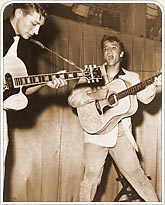 October 16, 1954
October 16, 1954
They appear for the first time on the Louisiana Hayride, a live
Saturday night country music radio show originating in Shreveport, Louisiana,
broadcast over KWKH Radio. The show is the Grand Ole Opry's chief
competitor, carried by 190 stations in thirteen states. This leads to regular
appearances on the Hayride and, in November, Elvis signs a one-year
contract for fifty-two Saturday night appearances. This is a great break, but as
Elvis’ popularity grows, his commitment to the Hayride prevents him from
traveling much outside the South to further his career on a larger scale. During
Elvis' association with the Hayride he meets “Colonel” Tom Parker,
a promoter and manager connected with various acts, and connected with the
Louisiana Hayride. Parker is also the manager for country star, Hank Snow. A
previous Parker client is country star Eddy Arnold.
1935 - 1957
January 1955
Elvis signs a contract with Bob Neal, who becomes his manager.
1955
Elvis, Scotty, and Bill continue touring on their own and in package shows
with various country stars,
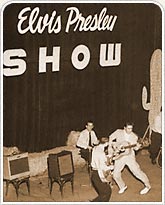 including
package tours of artists from the Hayride. Colonel Parker is involved.
This includes touring with Hank Snow. The regular Hayride appearances
continue. Drummer D.J. Fontana joins Elvis’ band. In the spring, Elvis fails to
be accepted on Arthur Godfrey’s Talent Scouts, a network television show.
As always, Elvis’ live appearances have special appeal for the teenagers,
especially the females. His unusual style, sexy moves, and good looks start to
cause more and more excitement wherever he plays. Sometimes the crowds break
through the barricades in near-riot behavior. Elvis gains more and more
popularity and begins to receive national attention. Colonel Parker becomes more
involved in Elvis’ career.
including
package tours of artists from the Hayride. Colonel Parker is involved.
This includes touring with Hank Snow. The regular Hayride appearances
continue. Drummer D.J. Fontana joins Elvis’ band. In the spring, Elvis fails to
be accepted on Arthur Godfrey’s Talent Scouts, a network television show.
As always, Elvis’ live appearances have special appeal for the teenagers,
especially the females. His unusual style, sexy moves, and good looks start to
cause more and more excitement wherever he plays. Sometimes the crowds break
through the barricades in near-riot behavior. Elvis gains more and more
popularity and begins to receive national attention. Colonel Parker becomes more
involved in Elvis’ career.
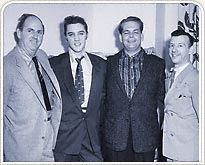 August 15, 1955
August 15, 1955
Elvis signs a management contract with Hank Snow Attractions, which is
owned equally by Snow and Colonel Tom Parker. Bob Neal remains involved as an
advisor. Colonel Parker is to be Elvis’ exclusive manager from this time on, and
Snow is soon no longer connected to Elvis.
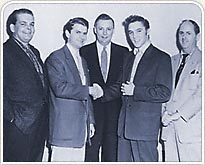 November 20, 1955
November 20, 1955
Elvis signs his first contract with RCA Records. Colonel Parker negotiates
the sale of Elvis’ Sun contract to RCA, which includes his five Sun singles and
his unreleased Sun material. The price is an unprecedented $40,000, with a
$5,000 bonus for Elvis. RCA soon re-releases the five Sun singles on the RCA
label. At the same time Elvis signs a contract with Hill and Range Publishing
Company, which is to set up a separate firm called Elvis Presley Music, Inc.
Elvis will share with Hill and Range the publishing ownership of songs bought by
Hill and Range for him to record. Elvis is the hottest new star in the music
business.
January 10, 1956
Two days after his twenty-first birthday, Elvis has his first recording
session for RCA, held at their studio in Nashville. Among the songs laid to tape
during this session is "Heartbreak Hotel."
The Jordanaires, a gospel quartet and popular country
back-up group, begin working with Elvis in the studio during the first few RCA
sessions and soon begin touring with him. They will also appear with him in
several films and remain his main back-up group until the late sixties.
1935 - 1957
January 27, 1956
"Heartbreak Hotel" b/w "I Was the One" is released by RCA and sells over
300,000 copies in its first three weeks on the market. It is soon to go to
number one on Billboard’s pop singles chart for eight weeks and hit number one
on the country chart and number five on the R&B chart. It becomes the first
Elvis single to sell over one million copies, thus earning Elvis his very first
gold record award.
January 28, 1956
Elvis appears with Scotty, Bill, and D.J. on the Jackie Gleason-produced
Stage Show, starring Tommy and Jimmy Dorsey on CBS. This is Elvis’ first
network television appearance. He appears five more nights on Stage Show
over the weeks ahead and makes minor waves nationally. The last of these six
appearances is March 24. Traveling and personal appearances continue during this
time, including the Louisiana Hayride appearances for which he is still
under contract. Fame and “infamy” build.
February, 1956
As "Heartbreak Hotel" makes its climb up the charts on its way to number
one, "I Forgot to Remember to Forget" b/w "Mystery Train", Elvis' fifth and last
single to be released on the Sun label, hits number one on Billboard’s national
country singles chart. His first number one hit on a national chart.
March 13, 1956
RCA releases Elvis Presley, Elvis’ first album. The album soon goes
to number one on Billboard’s pop album chart for ten weeks. It is the first
Elvis album to reach over $1 million in sales, thus earning Elvis his first gold
album award.
April 1, 1956
Elvis has a screen test for Paramount Studios in Hollywood. He lip synchs
"Blue Suede Shoes" and he performs a scene from the as yet unmade film, The
Rainmaker, a film he does not end up being in.
April 3, 1956
Elvis appears on The Milton Berle Show on ABC, which, for this
particular broadcast, originates from the deck of the aircraft carrier, the USS
Hancock.
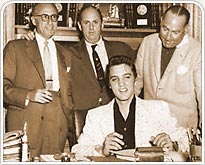 April 6, 1956
April 6, 1956
Elvis signs a seven-year movie contract with Hal Wallis and Paramount
Pictures.
April 23 - May 9, 1956
Compared to the usual hysteria, Elvis has lukewarm acceptance for his
two-week engagement at the New Frontier Hotel in Las Vegas. He is not exactly
what the adult audience of Vegas gamblers relates to very well. During these two
weeks,
the single Heartbreak Hotel and the album Elvis Presley both hit number one on
the Billboard pop charts.
Through all of this, the travel and personal appearances around
the country and new record releases continue. The crowds get bigger and bigger,
wilder and wilder. Elvis’ fame grows dramatically. Some of these shows have to
end early due to fans’ storming the stage. Elvis creates pandemonium wherever he
goes.
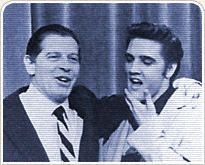 June
5, 1956
June
5, 1956
Elvis appears again on The Milton Berle Show, this time in the
studio where the show usually originates, this time backed by the Jordanaires in
addition to Scotty, Bill and D.J. Among his selections is a playfully sensuous
performance of "Hound Dog" that drives the kids in the audience wild, and, the
next day, has the press and some of the adult viewers appalled. It is one of his
most controversial performances. This merely serves to fuel his seemingly
unstoppable popularity even more.
Traveling and personal appearances and new record releases
continue. By this time Elvis, with his sexy moves and black-influenced sound, is
being condemned by certain factions of the “morally concerned” establishment and
the religious community. But, the kids love it.
July 1, 1956
Elvis appears on The Steve Allen Show on NBC. Among his performances
this night is a much toned down version of "Hound Dog". Allen has Elvis dressed
in white tie and black tux with tails and has him sing the song to a live Basset
hound, a tongue-in-cheek response to all controversy created by the Berle
appearance the month before. Elvis good-naturedly goes along with it, but is not
too happy about it. Elvis also appears in a cowboy comedy sketch with Allen,
Imogene Coca and Andy Griffith.
Record releases, touring, and recording continue. The
condemnation and controversy continue along with the ever-growing popularity. Ed
Sullivan, who had said that he would never have the likes of Elvis Presley on
his show, changes his tune when he sees the big ratings that Elvis attracts to
the Berle and Allen shows. A three-appearance deal is worked out for $50,000 and
is the highest amount ever paid to a performer, up to that time, for appearing
on a variety show.
1935 - 1957
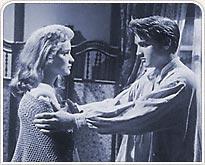 August 1956
August 1956
Elvis begins shooting his first movie, Love Me Tender on loan-out
from Paramount to Twentieth Century Fox. It is originally titled The Reno
Brothers, but is re-titled before its release to capitalize on Elvis’
sure-to-be-a-hit single from the soundtrack.
September 9, 1956
Elvis makes the first of three appearances on the Ed
Sullivan Show, the top television program of the era. Elvis attracts the
highest ratings ever for any television variety show. Character actor Charles
Laughton hosts in place of Sullivan, who is recuperating from a car accident.
In order to listen to audio and view video you will need Real
Player. Click here to download
Real Player.
 |
 |
Don't Be Cruel |
 |
Introducing New Song |
 |
Love Me Tender |
 |
Ready Teddy |
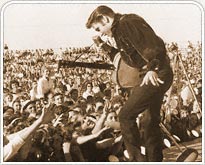 September 26, 1956
September 26, 1956
Elvis Presley Day is proclaimed in Tupelo, Mississippi. Elvis’ parents join
him as he returns to the town of his birth as a big star. He performs two shows
at the Mississippi-Alabama Fair and Dairy Show, the same fair at which he had
performed at age 10. This time there are a hundred National Guardsmen
surrounding the stage to control the crowds of excited fans.
By this time, souvenir merchandising using Elvis’ name,
image, and likeness has become a big part of the Elvis phenomenon. Licensees
will soon be producing as many as thirty different products including hats,
T-shirts, jeans, kerchiefs, sneakers, shirts, blouses, belts, purses, billfolds,
wallets, charm bracelets, necklaces, magazines, gloves, bookends, a statue,
lipstick, cologne, stuffed hound dogs, stationery, sweaters, crockery, and more.
Elvis and the Colonel are to blaze new trails in the area of celebrity
merchandising. This is to be forever a part of the marketing of Elvis Presley,
feeding a never-ending demand.
In order to listen to audio and view video you will need Real
Player. Click here to download
Real Player.
 |

|
Interview with Vernon and Gladys Presley |

|
Interview with Elvis Presley |
October 28, 1956
Elvis makes his second of three appearances on Ed Sullivan.
In order to listen to audio and view video you will need Real
Player. Click here to download
Real Player.
 |
Love Me Tender |
 |
Love Me |
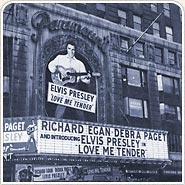 November 16, 1956
November 16, 1956
Elvis’ first movie, Love Me Tender premieres at the Paramount
Theater in New York City, opening nationwide in the days following. It becomes a
smash hit, and the critics’ reviews aren’t bad for his acting in this melodrama,
which is set in the American South of the 1800’s Civil War era. The film has
Elvis performing several songs, of course.
In order to listen to audio and view video you will need Real
Player. Click here to download
Real Player.
 |

|
Love Me Tender |
1935 - 1957
December 31, 1956
The front page of The Wall Street Journal reports that in the past
few months Elvis merchandise has grossed $22 million in sales.
Elvis ends the pivotal year of his career, when regional
popularity gave way to unprecedented national and international fame. The year
of 1956 has seen the beginning of Elvis souvenir merchandising, the beginning of
a successful movie career, huge record sales (five number one singles on the pop
chart, two number one albums on the pop chart, and other hits), history-making
television appearances, record-breaking personal appearances and more.
Elvis has become the primary symbol of the new youth
culture in America. He has also become one of society’s most controversial
figures. His unique blending of white country and gospel music, black R&B and
gospel, white pop music, his particular brand of charisma and talent, and the
resulting success and controversy, have helped him greatly to begin, without
premeditation, a cycle of change in music and pop culture and the mores of
American society. Nothing will ever be the same for Elvis Presley or for the
world.
January 6, 1957
Elvis makes his third and final appearance on Ed Sullivan’s Toast of the
Town Show. It is for this appearance that Elvis is seen only from the waist
up. It’s funny that after all of his television appearances the previous year,
such censorship comes at this time. It is particularly amusing that this
guideline remains in place during Elvis’ performance of the gospel standard,
Peace in the Valley, one of five songs he performs on this Sullivan
appearance. Ed Sullivan himself helps diffuse some of the controversy
surrounding Elvis when he comes out on stage to thank Elvis and tells the studio
audience and millions of American television viewers that “this is a decent,
fine boy” and what a delight he has been to work with when appearing on the
show. Ed Sullivan is the most influential person on television audiences and one
of the most powerful people in the television industry at the time.
Personal appearances, recording sessions, record releases,
controversy, and publicity continue.
In order to listen to audio and view video you will need Real
Player. Click here to download
Real Player.
 |
Too Much |
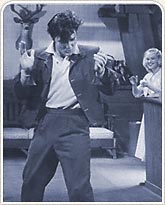 January, 1957
January, 1957
Elvis begins production of his second movie, Loving You.
In order to listen to audio and view video you will need Real
Player. Click here to download
Real Player.
 |

|
Loving You |
 |

|
Teddy Bear |
 |

|
Hot Dog |
 |

|
Mean Woman Blues |
February 3, 1957
The New York Times runs a story entitled, "Presley Records a Craze
in Soviet Union." Elvis records are not legally available in the Soviet Union.
The article tells of bootleg recordings being cut on discarded X-ray plates and
being sold in Leningrad on the black market for fifty rubles (about twelve and a
half dollars) each, a lot of money at the time.
March 1957
Elvis buys Graceland Mansion for himself, his parents, and his paternal
grandmother to live in. It will be ready for them to move into in early April.
April , 1957
While touring with his show, Elvis performs outside the United States for
the first time when he appears in Canada: two shows in Toronto on April 2 and
two shows in Ottawa on April 3.
May, 1957
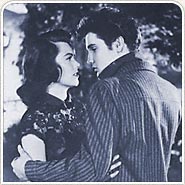 Elvis begins work on his third motion picture, Jailhouse Rock for
MGM.
Elvis begins work on his third motion picture, Jailhouse Rock for
MGM.
In order to listen to audio and view video you will need Real
Player. Click here to download
Real Player.
 |

|
Jailhouse Rock |
 |

|
(You're So Square)
Baby, I Don't Care |
 |

|
Treat Me Nice |
July 9, 1957
Elvis' second motion picture, Loving You, premieres and quickly
reaches the top ten at the box office. Hit records include the title song and
the classic smash "Teddy Bear".
Traveling, touring, record releases, and personal
appearances continue.
August 31, 1957
Elvis performs in Vancouver. This is the third Canadian city he has
performed in, and marks the last time he will perform in concert outside the
United States.
September 27, 1957
Elvis returns once more to the town of his birth to perform. This time it
is a benefit for the proposed Elvis Presley Youth Recreation Center in Tupelo,
Mississippi. The grounds include Elvis’ birthplace home. He will donate
regularly to the center for the rest of his life. (The center is still used by
the general community today. The birthplace home is open for tours, and there is
a small museum and a memorial chapel.)
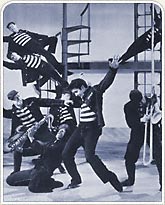 October 17, 1957
October 17, 1957
Jailhouse Rock, Elvis’ third motion picture, premieres in Memphis,
opening nationally in November and quickly going to the top five at the box
office. The title song is a smash hit. Years later, this film will be considered
one of Elvis’ best acting performances, surpassed only by King Creole,
which is to follow in 1958. Jailhouse Rock will come to be considered the
ultimate classic of all “rock opera” movies, and the "Jailhouse Rock" production
number in the film is to be recognized as the grandfather of pop/rock music
videos, a music format to become widely popular by the 1980’s.
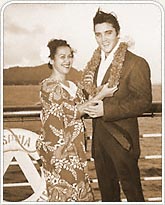 November 10, 11 1957
November 10, 11 1957
Elvis performs shows in Hawaii for the first time.
December, 1957
Elvis and family enjoy their first Christmas at Graceland and Elvis
officially receives his draft notice, a day he has known would be coming soon.
1958 to 1965
Late January- Early March, 1958
Elvis films and records for his fourth motion picture, King Creole.
March 15, 1958
Elvis performs two shows in Memphis. These are to be his last stage
performances until after his army release in 1960.
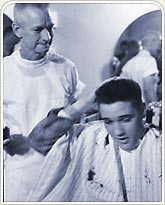 March 24, 1958
March 24, 1958
Elvis Presley is inducted into the U.S. Army at the Memphis Draft Board and
is assigned serial number 53310761.
March 25, 1958
Elvis gets his famous G.I. haircut at Fort Chaffee, Arkansas.
March 29, 1958
Private Presley arrives at Fort Hood, Texas for basic training and is
stationed there for six months. His parents soon move to a temporary home near
the base.
June 10, 1958
After basic training, while on his first leave, Elvis has a recording
session, his last until 1960.
July, 1958
King Creole, Elvis’ fourth motion picture opens nationally and the
reviews are the best he will ever have for his acting.
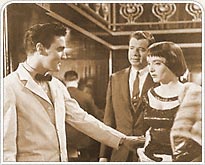 Its impressive list of co-stars and supporting cast includes Carolyn Jones,
Walter Matthau, Dean Jagger and Vic Morrow. It becomes a top five film at the
box office. This Michael (Casablanca) Curtiz-directed movie, set in New Orleans
and based upon the Harold Robbins novel, "A Stone for Danny Fisher," will come
to be regarded as Elvis’ finest film, his greatest acting performance, and proof
positive of his potential to have become a respected serious actor, though the
realization of this desire will remain forever out of his grasp.
Its impressive list of co-stars and supporting cast includes Carolyn Jones,
Walter Matthau, Dean Jagger and Vic Morrow. It becomes a top five film at the
box office. This Michael (Casablanca) Curtiz-directed movie, set in New Orleans
and based upon the Harold Robbins novel, "A Stone for Danny Fisher," will come
to be regarded as Elvis’ finest film, his greatest acting performance, and proof
positive of his potential to have become a respected serious actor, though the
realization of this desire will remain forever out of his grasp.
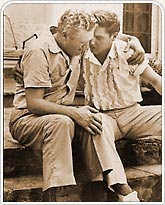 August, 1958
August, 1958
Gladys Presley becomes ill and returns to Memphis to be hospitalized with
acute hepatitis. Elvis is granted emergency leave and arrives in Memphis on the
afternoon of August 12th. He visits her that night, and the next day and night.
A few hours after Elvis goes home to Graceland to rest, she dies in the early
hours of August 14 at age 46. Her body lies in state at Graceland that
afternoon. Services are at the Memphis Funeral Home on the 15th, with the
Blackwood Brothers singing "Precious Memories" and "Rock of Ages," two of Gladys
Presley’s favorite hymns. She is laid to rest at Forest Hill Cemetery, a few
miles down the road from Graceland. Elvis is devastated.
August 25, 1958
Elvis reports back to Fort Hood.
September/October 1958
September 19, Elvis boards a troop train to New York, later boards the USS.
Randall and sails to Germany, arriving on October 1. He will be stationed in
Friedberg for 18 months, maintaining an off-base residence in Bad Nauheim,
shared with his father and grandmother, and some friends from Memphis. He finds
the fans in Europe to be as enthusiastic as those in America.
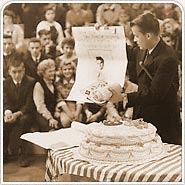
January 8, 1959
Elvis is interviewed off-camera via trans-Atlantic telephone by Dick Clark
on his American Bandstand show on ABC-TV. The show commemorates the
star’s twenty-fourth birthday. (Elvis never performed on American Bandstand.)
On a two-week leave, Elvis visits Munich, then goes clubbing in Paris,
which includes a visit to the Lido.
Colonel Parker continues to keep Elvis’ career alive with
promotions and hit record releases.
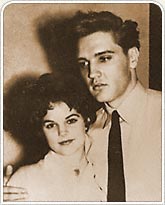 November 1959
November 1959
Captain Joseph Beaulieu is transferred from Texas to Weisbaden Air Force
Base near Friedberg, accompanied by his wife and children, including his
fourteen-and-a-half- year-old stepdaughter, Priscilla Ann. (Priscilla is the
only child from Ann Beaulieu’s marriage to her first husband, James Wagner, a
Navy pilot who was killed in a plane crash when Priscilla was an infant.)
Through a mutual friend, Priscilla is invited to a party at Elvis’ home soon
after her arrival in Germany. They meet, and the rest is history.
1958 - 1965
January 20, 1960
Elvis is promoted to Sergeant.
March 1960
Elvis leaves Germany on March 1, arriving in New Jersey the next day for a
press conference, and is officially discharged from active duty on March 5,
1960. He boards a train for Memphis, arriving on March 7. Press and crowds of
fans are everywhere for this historic series of events. He holds a press
conference at Graceland in his father’s office behind the mansion on March 8.
In order to listen to audio and view video you will need Real
Player. Click here to download
Real Player.
 |

|
1960 Press Conference |
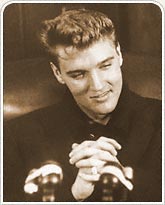 He
has served his country just like any other GI, with no special privileges his
celebrity status might have afforded him. These two years away from his career
have been a time to mature. He has also worried constantly that his lengthy
absence might have damaged his career progress. But, he has yet to see his
greatest stardom.
He
has served his country just like any other GI, with no special privileges his
celebrity status might have afforded him. These two years away from his career
have been a time to mature. He has also worried constantly that his lengthy
absence might have damaged his career progress. But, he has yet to see his
greatest stardom.
Late March, 1960
Elvis has his first post-army recording session. Some of the recording work
is for the album Elvis is Back!, which will hit number two on the
Billboard pop chart. (Sessions will continue in early April.) On March 21 he
receives his first degree black belt in karate, an interest he developed while
in the army. On March 26 he tapes a special "Welcome Home, Elvis" edition of
Frank Sinatra’s ABC-TV variety show, for which he is paid $125,000, a record sum
for a variety show appearance at the time.
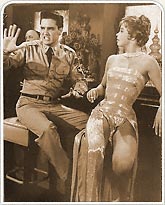 Late April, 1960
Late April, 1960
Elvis begins filming and recording for his first post-army movie, his fifth
film, "GI Blues" for Paramount, the first of nine to be produced (not
consecutively) by Hal Wallis. "GI Blues" co-stars dancer/actress Juliet Prowse.
May 8, 1960
ABC airs Frank Sinatra’s Welcome Home, Elvis edition of his variety
show, which attracts a 41.5% share of the national television audience.
July 3, 1960
Vernon Presley marries divorcee and mother of three sons, Davada (Dee)
Stanley, an American whom he met Germany, where she had been stationed with her
military husband. They live at Graceland briefly, then move to a home nearby.
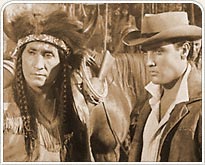 August/September 1960
August/September 1960
Elvis records and films for his sixth movie, Flaming Star, a drama
with limited music. Elvis plays the son of a white father and a Native American
mother, torn between the two cultures in the 1800's. The film co-stars Barbara
Eden.
October, 1960
The soundtrack album for GI Blues enters the Billboard album chart
and soon goes to number one. It remains number one for ten weeks and stays on
the chart for 111 weeks. It is to be the most successful album of Elvis’ entire
career on the Billboard charts. (In terms of total record sales over time, it is
uncertain which album stands as the most successful.)
 November 1960
November 1960
Elvis begins recording and filming for his seventh film, Wild in the
Country, which will be completed in January. GI Blues opens
nationally to warm reviews and big box office sales and is among the fifteen
top-grossing films of the year. It is a light comedy melodrama with lots of
singing by Elvis, who is seen in uniform for most of the movie.
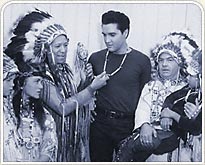 Late December, 1960
Late December, 1960
Flaming Star opens nationally to warm reviews, but unlike GI
Blues, this dramatic film with little singing does not set the box office on
fire. However, Elvis earns recognition from a tribal council for his positive
portrayal of a Native American in this racially charged drama. The film is
banned in South Africa due to its interracial theme.
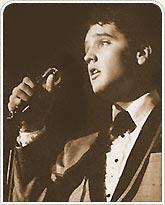 February 25, 1961
February 25, 1961
Elvis appears in Memphis at a luncheon in his honor, and numerous recent
awards Elvis has received are shown to the press and others attending. A press
conference follows. Then, Elvis performs one afternoon show and one evening show
at Ellis Auditorium to benefit around thirty-eight Memphis-area charities. Other
than the Sinatra television show, these shows are, so far, Elvis’ only live
performances since his army discharge. “Elvis Presley Day” is proclaimed by
Tennessee Governor Buford Ellington.
Every year after this, Elvis donates money to a list of Memphis-area charities,
eventually reaching fifty or more, usually around Christmas time. Within a few
years, to show their appreciation the city gives him a massive plaque listing
fifty charities.
1958 - 1965
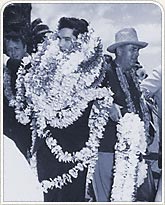 March 25, 1961
March 25, 1961
Elvis arrives in Hawaii for a press conference, then an evening concert at
Bloch Arena at Pearl Harbor. He is there to perform a benefit to help fund the
building of the USS Arizona Memorial.
Hundreds of fans mob the airport as he arrives. His show raises around $65,000
for the memorial, with related promotions bringing the total to about $100,000.
The event also helps bring publicity and public awareness and support to the
project. The fund-raising efforts, for the most part, had been difficult up to
this point. The rest of the needed funds are soon raised, and the memorial is
completed a year later.
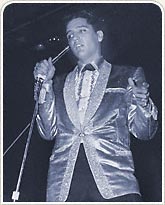 Elvis receives numerous official honors in appreciation for this benefit. This
turns out to be Elvis’ last live, non-movie performance until his 1968
television special.
Elvis receives numerous official honors in appreciation for this benefit. This
turns out to be Elvis’ last live, non-movie performance until his 1968
television special.
Late March/Mid- April, 1961
Elvis remains in Hawaii to do location filming for his eighth motion
picture, Blue Hawaii, having already done soundtrack recording. Later,
there is additional filming to be done back in Hollywood for this film. From
this time on, Elvis will have a fondness for Hawaii.
June, 1961
Wild in the Country, co-starring Hope Lange, Millie Perkins and
Tuesday Weld, opens nationally to mixed reviews. Like Flaming Star it is
a melodrama with limited singing by Elvis. It, too, does not set the box office
on fire.
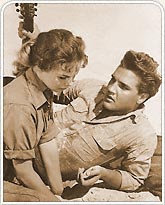 July, 1961
July, 1961
Elvis records and films for his ninth motion picture, Follow That Dream.
Filming includes some location shooting in Florida.
Non-movie-related hit records and recording sessions have also
continued through this period.
October, 1961
The soundtrack album for Blue Hawaii enters the Billboard chart for
a year-and-a-half run, staying at number one for twenty weeks, second only to GI
Blues as the biggest album of Elvis’ career on the Billboard charts. It also
yields a number two single destined to become an Elvis classic, Can’t Help
Falling in Love.
Non-movie-related recordings and hit records have continued
through this period, with Good Luck Charm hitting number one in 1962, his last
number one pop hit until Suspicious Minds in 1969.
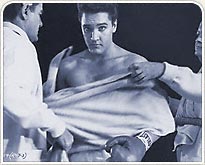 October/November, 1961
October/November, 1961
Elvis records and films for his tenth motion picture, Kid Galahad,
completing it in January.
Late November 1961
Blue Hawaii opens nationally to warm reviews and gets to number two
on the box office charts. It becomes the top-grossing film of Elvis’ career thus
far. Its characteristics of a non-cerebral plot, lavish scenery, lots of songs
by Elvis, and lots of pretty girls become the basis for the “Presley formula”
movies of the sixties, though most of them will not be nearly so well done.
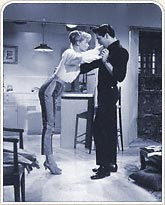 Late March/Late April, 1962
Late March/Late April, 1962
Elvis records and films in Hollywood, and does location filming in Hawaii
for his eleventh motion picture, Girls! Girls! Girls!.
May/June 1962
Follow That Dream opens nationally and gets to number five on the
box office charts. It is warmly reviewed and does fairly well in sales.
Late August/September 1962
Elvis records and films for his twelfth motion picture, It Happened at
the World’s Fair. Shooting is both in Hollywood and on location at the
World’s Fair in Seattle.
Kid Galahad opens nationally and does relatively well
with a brief stay in the top ten on the box office chart.
October 1962
In Mexico, riot behavior in a theater showing GI Blues prompts the
Mexican government to ban Elvis movies. Torn seats, broken windows, and other
damage is reported.
November 1962
Girls! Girls! Girls! opens nationally and rivals Blue Hawaii in box
office success. This is the second film to use the so-called “Presley formula”,
and it works. The soundtrack album goes top five and yields the hit single
Return to Sender.
December 1962
Priscilla Beaulieu had flown from West Germany to visit Elvis in Los Angeles in
the summer of this year for their first time to see each other after his army
discharge. In December her parents allow her to spend the Christmas holidays
with him at Graceland in Memphis. She returns to her family briefly, then moves
to Graceland in early 1963, finishing her senior year of high school in Memphis
and turning eighteen years old on May 24, 1963.
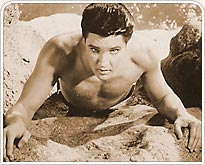 Late January/February 1963
Late January/February 1963
Elvis records and films for his thirteenth film, another “formula” movie,
Fun in Acapulco.
1958 - 1965
April 1963
It Happened at the World's Fair opens nationally and does relatively
well at the box office, though its plot is the most frivolous of any Elvis film
so far. The soundtrack album goes top five.
Non-movie recordings and hits continue through this period.
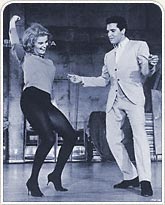 July 1963
July 1963
Elvis records the music, then, on location in Las Vegas and in a Hollywood
studio, he films for his fourteenth motion picture, Viva Las Vegas,
co-starring Ann-Margret. (It will be his fifteenth movie to be released as
Kissin’ Cousins, which he is to shoot next, will actually be released before
Viva Las Vegas.)
October 1963
Elvis records and shoots for his fifteenth motion picture, Kissin’ Cousins.
Late November 1963
Fun in Acapulco opens nationally and quickly goes to number five at
the box office. The soundtrack goes to the top five on the pop chart.
January/February 1964
Elvis purchases the Potomac, former presidential yacht of Franklin
Roosevelt, for $55,000. He intends to donate it to the March of Dimes for use as
a national shrine (FDR suffered from polio, the main disease fought by the March
of Dimes). Costs of maintaining the yacht would be prohibitive, so the March of
Dimes declines to accept the gift. Elvis attempts to give it to the 7th Coast
Guard District Auxiliary in Miami, which also doesn’t work out. Finally, on
February 13 he presents the yacht as a gift to a gift to St. Jude Children’s
Research Hospital in Memphis for them to use to raise funds as they see fit. The
ceremony takes place in Long Beach, California with actor and hospital founder,
Danny Thomas, accepting.
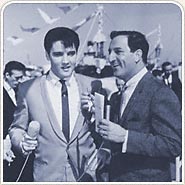
During this saga of trying to donate the yacht, the
Beatles make their first appearance on The Ed Sullivan Show and Sullivan
reads on the air a congratulatory telegram from Elvis and the Colonel. American
music and pop culture will soon change dramatically with the "British invasion",
much as it had after Elvis hit it big in the fifties.
Elvis has become bored and frustrated with his film and
recording career. It will only get worse.
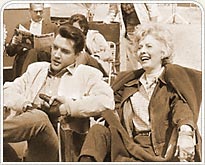 March 1964
March 1964
Kissin’ Cousins opens nationally. One of the poorest quality films
of his career, it still quickly hits number eleven at the box office, then
quickly falls, and the album goes top ten.
Elvis begins filming for his sixteenth motion picture,
Roustabout, co-starring Hollywood legend Barbara Stanwyck. He had recorded the
music during the previous month.
June 1964
Elvis records music for his next film, Girl Happy.
Viva Las Vegas opens nationally and goes to number
eight at the box office. It’s one of the better Elvis movies of this period, and
the songs are better as well.
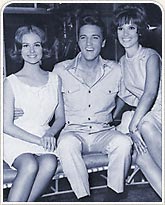 July/August 1964
July/August 1964
Elvis shoots his seventeenth motion picture, Girl Happy, which
co-stars Shelley Fabares and former Miss America, Mary Ann Mobley.
October 1964
Elvis begins shooting eighteenth motion picture, Tickle Me. The
soundtrack has no new recordings. Instead, previously released non-movie
recordings are used, apparently to keep production costs to a minimum.
November 1964
Roustabout opens nationally and hits number eight at the box office.
The soundtrack, which represents some of the best Elvis movie music in a while,
goes to number one on the Billboard pop album chart.
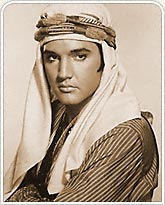 March/April 1965
March/April 1965
Elvis records the soundtrack and does the filming for his nineteenth motion
picture, Harum Scarum, which co-stars Mary Ann Mobley.
April 1965
Girl Happy opens nationally and does relatively good business. The
soundtrack album goes top ten.
Non-movie record releases have continued during this
period.
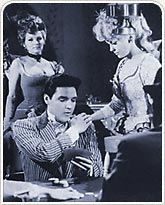 May 1965
May 1965
Elvis records music and does filming for his twentieth motion picture, to
be released out of chronology as his twenty-first, Frankie and Johnny,
co-starring Donna Douglas.
1958 - 1965
July 1965
Tickle Me opens nationally.
Elvis donates $50,000 to the Motion Picture Relief Fund,
reportedly the largest single donation the organization has ever received up to
this date. Accepting for the organization are Barbara Stanwyck and Frank
Sinatra.
August 1965
Elvis records soundtrack music for his twenty-first motion picture, Paradise,
Hawaiian Style, which will be released out of chronology as his twentieth,
then goes to Hawaii for location shooting. During a break in filming, he visits
the USS Arizona Memorial. The visit is covered by the press and prompts Hawaiian
Senator Daniel Inouye to have the visit recognized in the Congressional Record.
Elvis returns to Hollywood for more shooting for the film.
August 27, 1965
The Beatles visit with Elvis for several hours at his home in California
and have an informal jam session.
November 24, 1965
Harum Scarum opens nationally and hits number eleven at the box
office, then falls, as has been the pattern for most of Elvis’ movies during the
past few years. (Hit fast, burn out quickly, but make a sizable profit and sell
some records.) The soundtrack album goes to number eight.
1966 to 1969
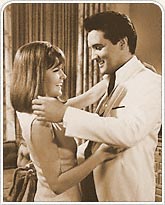 February 1966
February 1966
Elvis records the soundtrack music and shoots his twenty-second
motion picture, Spinout, co-starring Shelley Fabares.
March 1966
Frankie and Johnny opens nationally and doesn’t do
particularly well. The soundtrack album goes to number twenty.
June 1966
Paradise, Hawaiian Style is released and doesn’t do well. The
soundtrack album peaks at number fifteen.
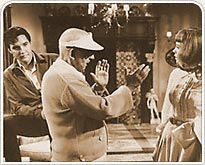 June-September 1966
June-September 1966
Soundtrack recording and shooting for Elvis’ twenty-third motion
picture (to be the twenty-fourth released), Double Trouble.
September 1966
Soundtrack recording and filming for Elvis’ twenty-fourth motion
picture (the twenty-third to be released), Easy Come, Easy Go.
November 1966
Spinout opens nationally and doesn’t do well. The soundtrack
album goes to number 18.
December 1966
Elvis formally proposes marriage to Priscilla.
February 1967
Elvis buys a 163-acre ranch in Mississippi, minutes across the
Tennessee state line from Graceland. He and his entourage and their wives had
become interested in horseback riding after Elvis purchased a horse for
Priscilla as a gift. The hobby had outgrown the pasture at Graceland. Over the
months to come, Elvis and the gang will enjoy spending a lot of time at the
Circle G. It becomes a happy diversion for Elvis as his frustration and
unhappiness over the state of his career reaches its height.
March 1967
Easy Come, Easy Go opens nationally and doesn’t do well.
RCA releases Elvis’ second gospel album, How Great Thou Art,
which was recorded in mid-1966. It gets very good reviews and goes on to earn
Elvis the Grammy Award for Best Sacred Performance from the National Academy of
Recording Arts & Sciences. This is the first of his three Grammy wins.
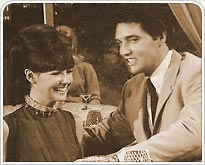 February-April, 1967
February-April, 1967
Soundtrack recording and filming for Clambake, Elvis’
twenty-fifth movie. It is the third of three Elvis movies to co-star Shelley
Fabares.
April 1967
Double Trouble opens nationally. Although better than some of
his recent screen efforts, it doesn’t do well at the box office.
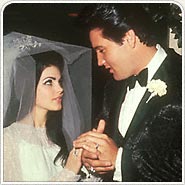 May 1967
May 1967
On May 1, Elvis and Priscilla are married in a private ceremony
amongst a small group of family and friends at the Aladdin Hotel in Las Vegas,
just after 9:30 AM. A press conference and breakfast reception follow. The
couple honeymoon for a few days in Palm Springs. Elvis wraps up some
over-dubbing on Clambake. Then they return to Memphis.
May 29, 1967
Elvis and Priscilla dress in their wedding clothes and have a second
wedding reception in the trophy room at Graceland to accommodate family and
friends who were not in Las Vegas for the wedding.
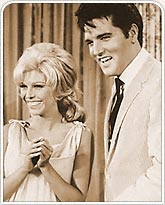
June-July 1967
Soundtrack recording and filming for Elvis' twenty-sixth movie (to
be the twenty-seventh released), Speedway, co-starring Nancy Sinatra.
During the production, news of Priscilla's pregnancy is announced.
September-November, 1967
Soundtrack recording and filming for Elvis' twenty-seventh movie (to
be the twenty-sixth released), Stay Away, Joe.
In this western-themed comedy he once again plays a character who is part Native
American. It's a real departure from the virtually interchangeable plots and
characters in most of the films over the past several grueling years. He has fun
with this one.
December 1967
Clambake is released nationally and goes to number fifteen at
the box office. The soundtrack album goes to number 40.
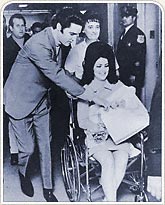
1966 - 1969
February 1, 1968
Priscilla gives birth to Lisa Marie Presley nine months to the day
after her marriage to Elvis. It is a time of great happiness.
March 1968
Stay Away, Joe opens to mixed reviews and doesn't do well at the box
office, though like all of Elvis’ films, it makes a profit.
Soundtrack recording and filming for Elvis' twenty-eighth
movie, Live a Little, Love a Little. It is a sexy, more adult kind of
comedy/ melodrama.
It, like Stay Away, Joe is a real departure from the typical Presley
film. It is yet another breath of fresh air.
June 1968
Speedway is released nationally and doesn’t do very well. The
soundtrack album goes only as far up the chart as number 82.
Mid-to-Late June, 1968
Elvis rehearses for the taping of his first television special. A
press conference is held on June 25th. Videotaping is done June 27, 28, 29, and
30. Commonly referred to as The ‘68 Special or The ‘68 Comeback.
the actual name of this landmark television special is Elvis.
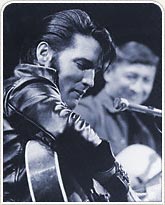 The sixties have brought about great change in music and pop culture.
Change for which Elvis helped pave the way over a decade earlier when he
exploded onto the scene with his unique blending of pop, rock, country, R&B and
gospel influences. Focusing on his Hollywood movie career in the sixties, Elvis
has become less a part of the current pop cultural scene. He has been making one
movie after another, and many of the records he has put out in these years have
been movie soundtrack albums. In the fifties and early sixties, the films and
film-related records were wonderfully successful, but as the sixties have worn
on, the movies and records, though still profitable, have not been nearly so
successful as they were before. Elvis has reached the supreme level of
frustration with the state of his career and all its limitations on his
creativity and artistic expression. He had hoped to become a serious actor, but
Hollywood had other ideas and Elvis went along with them. His opportunities to
show his true talents as an actor have been few. He is beyond ready for a
change. By now, it has been more than seven years since Elvis has appeared in
front of a live audience. Elvis has missed the closeness of his audience, the
energy and excitement of live performing.
The sixties have brought about great change in music and pop culture.
Change for which Elvis helped pave the way over a decade earlier when he
exploded onto the scene with his unique blending of pop, rock, country, R&B and
gospel influences. Focusing on his Hollywood movie career in the sixties, Elvis
has become less a part of the current pop cultural scene. He has been making one
movie after another, and many of the records he has put out in these years have
been movie soundtrack albums. In the fifties and early sixties, the films and
film-related records were wonderfully successful, but as the sixties have worn
on, the movies and records, though still profitable, have not been nearly so
successful as they were before. Elvis has reached the supreme level of
frustration with the state of his career and all its limitations on his
creativity and artistic expression. He had hoped to become a serious actor, but
Hollywood had other ideas and Elvis went along with them. His opportunities to
show his true talents as an actor have been few. He is beyond ready for a
change. By now, it has been more than seven years since Elvis has appeared in
front of a live audience. Elvis has missed the closeness of his audience, the
energy and excitement of live performing.
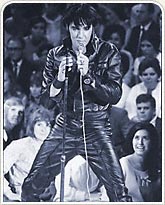 The '68 Special opens with Elvis singing a hot new version of the
gutsy "Trouble", from his 1958 film King Creole. This segues into
Guitar Man, which, with its semi-autobiographical lyrics, becomes the
underlying theme of the show. Then, Elvis is reunited with two of his original
fifties band members, guitarist Scotty Moore and drummer D.J. Fontana. (Bass
player Bill Black has been deceased for several years by this time.) They sit
together on stage in the round, along with several other friends and associates
of Elvis for an informal session of singing, jamming, and swapping stories.
Parts of this jam session are woven throughout the show. There are also
sequences of Elvis taking the stage alone and performing many of his greatest
hit rockers and ballads, and he introduces a new song, Memories.
The '68 Special opens with Elvis singing a hot new version of the
gutsy "Trouble", from his 1958 film King Creole. This segues into
Guitar Man, which, with its semi-autobiographical lyrics, becomes the
underlying theme of the show. Then, Elvis is reunited with two of his original
fifties band members, guitarist Scotty Moore and drummer D.J. Fontana. (Bass
player Bill Black has been deceased for several years by this time.) They sit
together on stage in the round, along with several other friends and associates
of Elvis for an informal session of singing, jamming, and swapping stories.
Parts of this jam session are woven throughout the show. There are also
sequences of Elvis taking the stage alone and performing many of his greatest
hit rockers and ballads, and he introduces a new song, Memories.
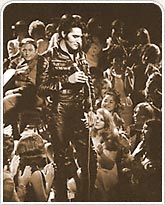
One can surmise that he pours out years of career
frustration and pent-up creative energy into the performance of these songs. His
natural talent, charisma, sensuality and stage presence have not been diminished
by the years in Hollywood. In fact, he looks, sounds, moves and grooves better
than he ever has. At 33, he is better than he has ever been. Better than anybody
in the business. For the group jam session segments and solo stage performances
Elvis wears a two-piece black leather outfit specially designed for the show by
Bill Belew, who also designed all the other wardrobe Elvis and the cast wear in
the show. The look evokes the era of James Dean and the Marlon Brando type
motorcycle films of the fifties, the era when Elvis was first proclaimed the
King of Rock 'n' Roll.
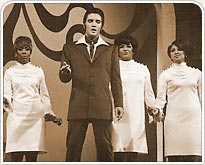 In one of the jam session segments, Elvis speaks of the gospel origins of
rock and roll. This segues into the gospel music portion of the show, which has
Elvis wearing a two-piece burgundy suit, singing "Where Could I Go But to the
Lord," "Up Above My Head" and "I’m Saved," backed by the female vocal group, The
Blossoms, and accompanied by a troupe of dancers - all of this for a rousing
gospel production number.
In one of the jam session segments, Elvis speaks of the gospel origins of
rock and roll. This segues into the gospel music portion of the show, which has
Elvis wearing a two-piece burgundy suit, singing "Where Could I Go But to the
Lord," "Up Above My Head" and "I’m Saved," backed by the female vocal group, The
Blossoms, and accompanied by a troupe of dancers - all of this for a rousing
gospel production number.
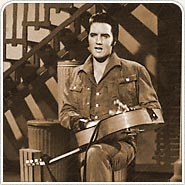 Toward the end of the special Elvis appears in a lengthy production number
that, through song, dance, karate, and various situations, traces a young man’s
journey from a struggling guitar player, through the challenges, dangers and
compromises on the path to his dreams of success and superstardom. Something is
lost along the way. Once the dream is achieved, the man realizes that he remains
unfulfilled, that he has abandoned his true self. He decides to return to his
roots, doing what made him happiest, what he does best. He sings “I’ll never be
more than what I am... a swingin’ little guitar man.” The parallels to Elvis'
own life are clear and deliberate, and his doing the ‘68 special represents his
own return to his true self, to his roots. Free from the confines of his
Hollywood grind, this is Elvis the singer, the performer, the musician, the man
- the real Elvis.
Toward the end of the special Elvis appears in a lengthy production number
that, through song, dance, karate, and various situations, traces a young man’s
journey from a struggling guitar player, through the challenges, dangers and
compromises on the path to his dreams of success and superstardom. Something is
lost along the way. Once the dream is achieved, the man realizes that he remains
unfulfilled, that he has abandoned his true self. He decides to return to his
roots, doing what made him happiest, what he does best. He sings “I’ll never be
more than what I am... a swingin’ little guitar man.” The parallels to Elvis'
own life are clear and deliberate, and his doing the ‘68 special represents his
own return to his true self, to his roots. Free from the confines of his
Hollywood grind, this is Elvis the singer, the performer, the musician, the man
- the real Elvis.
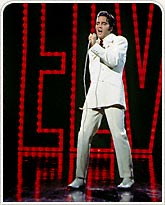 At the end of the special, Elvis appears alone wearing a simple white
two-piece suit, standing in front of the towering backdrop of red lights that
spell ELVIS. He sings a brand new song, "If I Can Dream," especially written for
the show. The writers created the song based in part upon conversations with
Elvis about his own thoughts on what was happening in the turbulent sixties. It
seemed appropriate that he close the show with some sort of personal statement.
His powerful and passionate performance of this song of hope for mankind is one
of the most brilliant moments of his singing career.
At the end of the special, Elvis appears alone wearing a simple white
two-piece suit, standing in front of the towering backdrop of red lights that
spell ELVIS. He sings a brand new song, "If I Can Dream," especially written for
the show. The writers created the song based in part upon conversations with
Elvis about his own thoughts on what was happening in the turbulent sixties. It
seemed appropriate that he close the show with some sort of personal statement.
His powerful and passionate performance of this song of hope for mankind is one
of the most brilliant moments of his singing career.
1966 - 1969
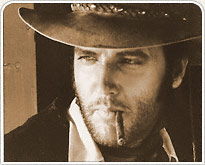 July/August, 1968
July/August, 1968
Elvis records the theme and does filming for his twenty-ninth movie,
Charro!, a dramatic western, again a very different kind of role. Elvis
grows a beard for this. The theme song will be heard over the opening credits,
but there will be no other Elvis songs used. This will be the first and only
film in which Elvis does not sing on camera.
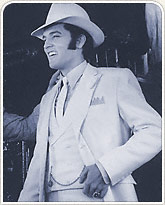 October-November 1968
October-November 1968
Elvis records the soundtrack and does filming for his thirtieth
movie, The Trouble with Girls (and How to Get into It). He sings in this
one, but in very natural situations for a change. It is yet another film quite
different from the typical Elvis films.
Live a Little, Love a Little opens in the U.S. in
October and doesn’t do very well.
"If I Can Dream," from the soon-to-be aired '68 special
hits number 12 on the pop singles chart in November, making it Elvis’ biggest
single since 1965.
December 3, 1968
Elvis, the 1968 TV special, first airs on NBC-TV and is one
of this biggest television hits of the year, receiving rave reviews from the
public and the critics alike. The soundtrack album goes to number eight on the
pop chart. Reviewing the show, rock writer John Landau says:
There is something magical about watching a man who has
lost himself find his way back home...He sang with the kind of power people no
longer expect from rock ‘n’ roll singers.
Years later, rock writer Greil Marcus will remember it
this way:
It was the finest music of his life. If ever there was
music that bleeds, this was it.
Elvis, the 1968 TV special, is to become widely
regarded as one of the truly great television moments in pop/rock music history.
After this show everything changes for Elvis. He pours renewed creative energy
into his recording work, is soon to wrap up his movie contract obligations and
to return full-time to the concert stage, beginning a new and exciting era of
his career. His superstardom is yet to reach its height.
December 1968
Elvis wraps shooting on The Trouble with Girls.
January/February 1969
Elvis has been doing all of his recording work in Nashville or
Hollywood since signing with RCA. But, now he records in Memphis again for the
first time since 1955. He has all-night marathon sessions at American Sound
Studio. His work here will become regarded as some of the finest music of his
career, his best work since the innovative days at Sun and the exciting early
days at RCA before he went into the army. Elvis has excellent material to choose
from and pours his heart and soul into the sessions. He works with a lot of
top-notch Memphis musicians. The sound is fresh and gutsy. On every track one
can sense his creative excitement and energy. This is joyful work after years of
movie boredom. Two albums will result from these sessions. The sessions will
also yield four hit singles to be released starting later this year and going
into 1970: "In the Ghetto", "Suspicious Minds", "Don’t Cry, Daddy" and "Kentucky
Rain".
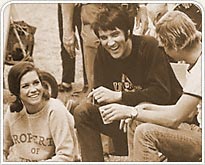 March/April 1969
March/April 1969
Elvis returns to Hollywood to film and record the soundtrack music
for his thirty-first, and what will turn out to be his last, acting role in a
motion picture. It is Change of Habit, co-starring Mary Tyler Moore.
Elvis plays a hip ghetto doctor in a Northern city, having come from Tennessee.
Mary Tyler Moore and two others play nuns who go “undercover” into the ghetto to
assist with health and societal troubles in the community. The theme, though
serious and timely, is not particularly well carried out by the script in the
opinion of many, and the title is frivolous. But, Elvis looks magnificent, and
gives a natural, easy, understated performance that is a refreshing pleasure to
see after the silliness he endured in his films through most of the sixties. The
few songs in the movie are good and they’re performed in natural, rather than
the usual badly contrived, situations.
March, 1969
Charro! opens in theaters and doesn’t do much at the box
office.
1966 - 1969
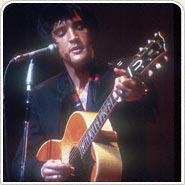 July 31 - August 28, 1969
July 31 - August 28, 1969
Elvis is booked for a four-week, fifty-seven show engagement at the
International Hotel in Las Vegas, which has just been built and has the largest
showroom in the city. Elvis puts together top-notch rock and roll musicians, an
orchestra, a male gospel back-up group, and a black female soul/gospel back-up
group for his show.* They rehearse for several weeks and open on July 31, 1969.
The show is a delightful mix of fresh arrangements of classic Elvis hits,
exciting new material he has recorded, a few covers of current and past hits of
other artists, and charming on-stage antics and sharing of personal
recollections of his career. A press conference follows the first of his two
opening night shows.
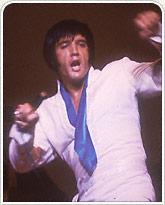 This engagement breaks all existing Las Vegas attendance records and
attracts rave reviews from the public and the critics. It is a triumph. Elvis'
first live album, Elvis in Person at the International Hotel, Las Vegas,
Nevada, is recorded during this engagement and is soon released.
This engagement breaks all existing Las Vegas attendance records and
attracts rave reviews from the public and the critics. It is a triumph. Elvis'
first live album, Elvis in Person at the International Hotel, Las Vegas,
Nevada, is recorded during this engagement and is soon released.
For these shows a lean Elvis in top physical form, wears
simple, unique, karate-inspired two-piece outfits in black or white. These are
designed by Bill Belew, who did the wardrobe for the ‘68 special. These are the
predecessors to the famous one-piece jumpsuits which will be simple at first,
then become flashier and more elaborate over the years.
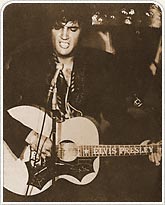 Here are a couple of reviews from music writers:
Here are a couple of reviews from music writers:
"There are several unbelievable things about Elvis, but
the most incredible is his staying power in a world where meteoric careers fade
like shooting stars."
- Newsweek ,
-8-11-69 issue.
"...a style and panache that come close to pure magic.
Lithe, raunchy, the sweat pouring down his face, he now moves with the precision
of an athlete, the grace of a dancer...flamboyant and flashy, sexy and
self-mocking, he works with the instincts of a genius to give poetry to the
basic rock performance."
- W.A. Harbinson
- From his 1975 book, The Illustrated Elvis. A passage reflecting on
Elvis' 1969 Vegas engagement.
*NOTE: The orchestra was conducted by Bobby Morris. The band
consisted of James Burton (lead guitar), John Wilkinson (rhythm guitar), Jerry
Scheff (bass guitar), Larry Muhoberac (piano) and Ronnie Tutt (drums). The
female singers were The Sweet Inspirations. The male singers were The Imperials.
Charlie Hodge provided additional guitar and vocals and general on-stage
assistance. Over the concert years there were changes in the show cast. Joe
Guercio became Elvis' conductor. Millie Kirkham, who had worked on Elvis' studio
recordings, joined the show as soprano, a position later taken over by Kathy
Westmoreland. Glen D. Hardin became the piano player. J.D. Sumner & the Stamps
Quartet became the male back-up group. Various other personnel changes occurred
over the years.
September 1969
The Trouble with Girls, Elvis’ thirtieth movie, opens in
theaters and doesn’t do much at the box office. From the American Sound Studio
sessions RCA releases "Suspicious Minds", which will soon become Elvis' first
number one single since "Good Luck Charm" in 1962, and will be his last number
one pop single, though he’ll have many big hits.
November 1969
Change of Habit, Elvis' thirty-first movie, opens in theaters
and doesn’t do much at the box office.
1970 to 1977
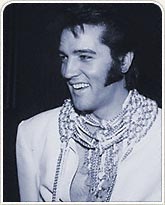
January/February 1970
Some say it is a mistake to go back to Vegas so soon, especially
during the slowest season for the city. Can he fill the seats?
But, Elvis returns to the International Hotel for another month-long engagement.
This time he breaks his own attendance records. Another live album is recorded,
On Stage, February 1970.
February/March 1970
A press conference in Houston on the 27th. Elvis performs afternoon
and evening shows at the Houston Astrodome. Two more shows follow on the 28th.
Two more follow on March 1. A closing press conference and banquet follow,
and Elvis is presented an armload of recent gold record awards. The six shows
attract 207,494 people and set records. There is speculation among the press and
the public that Elvis might tour in concert for the first time since the
fifties.
June 1970
Elvis has recording sessions in Nashville.
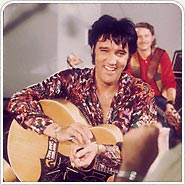 July/September 1970
July/September 1970
Back to Las Vegas for rehearsals for another month-long engagement
at the International. He opens on August 10 and closes on September 7.
MGM is on hand to shoot a documentary film called Elvis -That’s the Way It Is
that will show Elvis off stage, in rehearsals, in the recording studio, and on
stage.
RCA will also release an album with the same title.
In order to listen to audio and view video you will need Real
Player. Click here to download
Real Player.
 |
 |
Elvis, That's the Way It Is Theatrical Trailer |
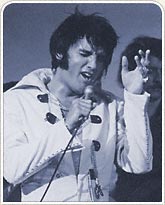 September 1970
September 1970
From the 9th through the 14th Elvis takes his show on a nine-city
tour. It is a smashing success, the first tour since 1957, only these days the
show is much more elaborate . MGM films portions of the first show on this tour
for use in Elvis - That’s the Way It Is.
Elvis has a recording session in Nashville.
November 1970
Elvis, That’s the Way It Is, Elvis thirty-second film, opens in
theaters to good reviews and good box office. Documentaries traditionally do not
do well at the box office, but this one makes a respectable showing. It, like
other Elvis movies will go on to have a life on television and home video in
years to come. An album of the same title is released, but only one song, I Just
Can't Help Believin', is actually from a stage performance included in the film.
The other songs are studio recordings, some of which Elvis performs live on
stage or in rehearsal footage in the film.
Elvis does a successful eight-city concert tour.
December 1970
Elvis’ famous visit with President Richard Nixon at the White House
occurs.
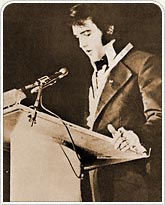 January 16, 1971
January 16, 1971
Elvis attends a day of functions culminating in an evening awards
banquet. He and nine others accept the honor of being named One of the Ten
Outstanding Young Men of the Nation by the United States Junior Chamber of
Commerce (The Jaycees). He is nervous about his acceptance speech. He is
touched, excited and deeply proud. This national honor has been given each year
since the late 1930’s and recognizes young men who have made great achievements
in their field of endeavor, illustrating the opportunities available in the free
enterprise system. It also applauds humanitarianism and community service.
Scientists, inventors, performers, film makers, politicians bound for the
Presidency, and men of greatness in all fields, have been selected for this
award over the years. For Elvis, a man who grew up poor, and, in his early
career knew the sting of ridicule from the Establishment, who, through the years
has known criticism of his work, this is one of his proudest moments. It is a
sign that he has achieved acceptance, recognition, and respect for his work and
for the kind of person he is.
Late January/February 1971
Elvis plays another month-long engagement at the International Hotel
in Las Vegas.
March 1971
Elvis begins a recording session in Nashville, but cancels it due to
pain and inflammation in an eye. He is treated at a Nashville hospital where he
is diagnosed with secondary glaucoma. This eye condition will plague him from
time to time in varying degrees for the rest of his life.
May 1971
Elvis is featured on the cover of Look Magazine, which carries an
installment of the forthcoming biography on Elvis by Jerry Hopkins. Many books
and articles have been written over the years, but this is the first in-depth,
serious biography. The book Elvis : A Biography will be released in October.
Elvis has recording sessions in Nashville. Much of the
work is for his forthcoming album Elvis Sings the Wonderful World of Christmas.
1970 - 1977
June 1971
The two-room house Elvis was born in opens to the public for tours,
having been restored by the East Heights Garden Club in Tupelo. Elvis has more
recording sessions in Nashville, this time mostly for an upcoming gospel album,
He Touched Me.
A long stretch of Highway 51 South, part of which runs in
front of Graceland, is officially renamed Elvis Presley Boulevard. The first of
the new street signs will go up in January of 1972.
Various albums and singles continue to be released to
various degrees of success during this period.
July/August 1971
Elvis plays a two-week engagement at the Sahara Hotel in Lake Tahoe,
Nevada.
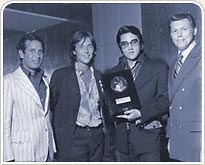 August 9 - September 6, 1971
August 9 - September 6, 1971
Elvis plays an engagement in Las Vegas at the International Hotel,
which has been renamed the Las Vegas Hilton International Hotel. He sets another
attendance record and tops himself once again.
During the engagement an award is presented to Elvis in
his dressing room. It is the Bing Crosby Award from the National Academy of
Recording Arts and Sciences (the organization that also presents Grammy awards).
This award is a special means of recognition from NARAS and is named for its
first recipient. The award is not given every year as a rule. It will later be
re-named the Lifetime Achievement Award. Elvis is 36 years old.
November 5-16, 1971
Elvis goes on a 12-city concert tour.
Late 1971, Early 1972
Elvis and Priscilla separate. She moves out on her own with Lisa
Marie.
January 26 - February 23, 1972
Elvis plays another successful engagement at the Hilton in Vegas.
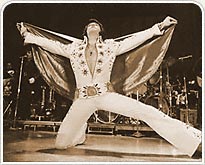 March/April 1972
March/April 1972
In April MGM films Elvis in a Hollywood recording studio, then films
on and off stage during his 15-city concert tour, which is a big success.
MGM will use the footage for another theatrically released documentary, Elvis on
Tour.
In April the gospel album He Touched Me is released to
good reviews. The album will go on to win Elvis his second Grammy Award, this
one for the category of Best Inspirational Performance.
June 1972
Elvis continues touring in concert, beginning with a press
conference in New York on the 9th. MGM is on hand to film the conference for use
in Elvis on Tour. Elvis makes entertainment history by performing four sold-out
shows at New York’s Madison Square Garden. John Lennon, George Harrison, Bob
Dylan, David Bowie, and Art Garfunkel are among the music stars spotted at the
shows.
Nine days after it is recorded, RCA rush-releases a live
album from one of the shows - Elvis as Recorded at Madison Square Garden. Elvis
tours to seven more cities.
Elvis' Vegas and concert tour career is hot, hot, hot
during the early to mid-seventies. He breaks attendance records in cities all
over America. Record releases also continue.
July 1972
Elvis and Priscilla’s separation is formalized. A divorce is to
come. Elvis has begun seeing Linda Thompson, who will be his main female
companion until late 1976.
August 4 - September 4, 1972
Elvis plays a month-long engagement at the Hilton in Vegas.
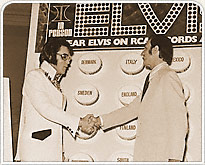 September 5, 1972
September 5, 1972
Elvis participates in a press conference in Vegas announcing plans for a
television concert to be broadcast via satellite around the world from Hawaii.
It is predicted that the show will reach the largest audience in television
history and that the live album will be a big hit.
October 1972
Elvis has a number two pop hit with the single Burning Love, one of
his biggest records in recent years.
November 1972
Elvis on Tour opens to good reviews and good box office performance
in theaters. Later, its producers will receive the Golden Globe Award for Best
Documentary of 1972. Like other Elvis films it will have a life on television
and on home video.
Elvis tours seven cities in concert. The last is Honolulu,
Hawaii, where he does three shows at the Honolulu International Center Arena,
the same venue that will host his satellite special in January. Elvis appears at
a press conference in Hawaii regarding his upcoming satellite show. It is
announced that it will be a benefit for the Kui Lee Cancer Fund.
1970 - 1977
January 1973
Elvis makes television and entertainment history with his Elvis: Aloha from
Hawaii - Via Satellite special. Performed at the Honolulu International Center
Arena on January 14, 1973, broadcast live at 12:30 AM Hawaiian time, beamed via
Globecam Satellite to Australia, South Korea, Japan, Thailand, the Phillipines,
South Vietnam and other countries. It is seen on a delayed basis in around
thirty European countries. A tape of the show will be seen in America on April
4th on NBC. The live broadcast in January attracts 37.8% of the viewers in
Japan, 91.8% in the Philippines, 70% in Hong Kong, and 70-80% of the viewers in
Korea. The April showing in America will attract 51% of the television viewing
audience, and will be seen in more American households than man’s first walk on
the moon. In all, it will be seen in about forty countries by one billion to 1.5
billion people. Elvis commissions an American Eagle design for his jumpsuit for
this show, his patriotic message to his worldwide audience.* Never has one
performer held the world’s attention in such a way. Elvis is in top form
physically and vocally. This is probably the pinnacle of his superstardom, one
of the all-time great moments of his career.
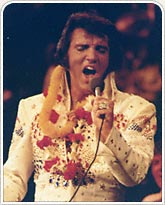 Audience tickets for the January 14 concert and its January 12
pre-broadcast rehearsal show carry no price. Each audience member is asked to
pay whatever he or she can. The performances and concert merchandise sales are a
benefit raising $75,000 for the Kui Lee Cancer Fund in Hawaii. (Kui Lee was a
Hawaiian composer who had died of cancer while still in his thirties.)
Audience tickets for the January 14 concert and its January 12
pre-broadcast rehearsal show carry no price. Each audience member is asked to
pay whatever he or she can. The performances and concert merchandise sales are a
benefit raising $75,000 for the Kui Lee Cancer Fund in Hawaii. (Kui Lee was a
Hawaiian composer who had died of cancer while still in his thirties.)
On stage with Elvis is an orchestra and his current show
cast: Joe Guercio (conductor), J.D. Sumner & the Stamps (vocals), The Sweet
Inspirations (vocals), Kathy Westmoreland (soprano vocals), Charlie Hodge
(guitar/vocals/on-stage assistance), James Burton (lead guitar), John Wilkinson
(rhythm guitar), Jerry Scheff (bass guitar), Glen D. Hardin (piano), and Ronnie
Tutt (drums).
The soundtrack album is soon released and goes to number
one on the Billboard pop album chart, and stays on the chart at various
positions for 52 weeks. The show will later have continued life on television
and eventually home video.
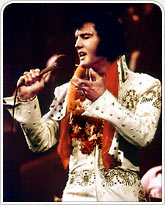 In the special, Elvis' recording of the theme song from his 1965 movie
Paradise, Hawaiian Style plays over the opening credits and scenes of Elvis'
helicopter arrival at the airport and his walking among the fans who are there
to greet him. The concert opens with Elvis' band playing his traditional
introduction for his seventies concerts, Theme from 2001. He sings See, See
Rider, Burning Love, Something, You Gave Me a Mountain, Steamroller Blues, My
Way, Love Me, Johnny B. Goode, It’s Over, Blue Suede Shoes, I’m So Lonesome I
Could Cry, I Can’t Stop Loving You, Hound Dog, What Now, My Love, Fever, Welcome
to My World, Suspicious Minds, I’ll Remember You (A Kui Lee composition Elvis
sings after announcing the sum raised for the Kui Lee Cancer Fund.), Long Tall
Sally/Whole Lotta Shakin’ Goin’ On, An American Trilogy (Elvis tosses his belt
into the audience), A Big Hunk o’ Love, and Can’t Help Falling in Love (Elvis
tosses his cape into the audience). The show is one hour, including commercials.
After the show, Elvis and his bandmates come back out on stage in the empty
arena and videotape performances of the songs Blue Hawaii, Ku-u-i-po, and
Hawaiian Wedding Song which he had first done for his 1961 hit movie, Blue
Hawaii, plus Early Morning Rain and No More. All but the song No More will be
inserted into the American broadcast with Elvis seen on a montage screen with
footage of Hawaiian scenery.
In the special, Elvis' recording of the theme song from his 1965 movie
Paradise, Hawaiian Style plays over the opening credits and scenes of Elvis'
helicopter arrival at the airport and his walking among the fans who are there
to greet him. The concert opens with Elvis' band playing his traditional
introduction for his seventies concerts, Theme from 2001. He sings See, See
Rider, Burning Love, Something, You Gave Me a Mountain, Steamroller Blues, My
Way, Love Me, Johnny B. Goode, It’s Over, Blue Suede Shoes, I’m So Lonesome I
Could Cry, I Can’t Stop Loving You, Hound Dog, What Now, My Love, Fever, Welcome
to My World, Suspicious Minds, I’ll Remember You (A Kui Lee composition Elvis
sings after announcing the sum raised for the Kui Lee Cancer Fund.), Long Tall
Sally/Whole Lotta Shakin’ Goin’ On, An American Trilogy (Elvis tosses his belt
into the audience), A Big Hunk o’ Love, and Can’t Help Falling in Love (Elvis
tosses his cape into the audience). The show is one hour, including commercials.
After the show, Elvis and his bandmates come back out on stage in the empty
arena and videotape performances of the songs Blue Hawaii, Ku-u-i-po, and
Hawaiian Wedding Song which he had first done for his 1961 hit movie, Blue
Hawaii, plus Early Morning Rain and No More. All but the song No More will be
inserted into the American broadcast with Elvis seen on a montage screen with
footage of Hawaiian scenery.
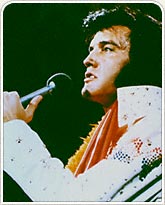 A Little History on Elvis' Costume: Elvis told Bill Belew he wanted the
jumpsuit for this special to say “America” to the worldwide viewing audience.
Bill told Elvis that, except for the American flag, he could think of nothing
other than the American Eagle. Elvis said “I like it.” And that’s how one of
Elvis' most famous costumes came to be. Elvis had been wearing jumpsuits on
stage since 1970, and they had become quite elaborate by the time of this show.
For the past year or two he had been wearing studded, hip-length capes and heavy
studded leather belts with his jumpsuits. For the American Eagle jumpsuit, Bill
first designed a huge calf-length cape. During preparations for the show, Elvis
tried working with this cape, but it was just too cumbersome to use. So, out
went the emergency order for another cape in the usual size.
A Little History on Elvis' Costume: Elvis told Bill Belew he wanted the
jumpsuit for this special to say “America” to the worldwide viewing audience.
Bill told Elvis that, except for the American flag, he could think of nothing
other than the American Eagle. Elvis said “I like it.” And that’s how one of
Elvis' most famous costumes came to be. Elvis had been wearing jumpsuits on
stage since 1970, and they had become quite elaborate by the time of this show.
For the past year or two he had been wearing studded, hip-length capes and heavy
studded leather belts with his jumpsuits. For the American Eagle jumpsuit, Bill
first designed a huge calf-length cape. During preparations for the show, Elvis
tried working with this cape, but it was just too cumbersome to use. So, out
went the emergency order for another cape in the usual size.
January 26 - February 23, 1973
Elvis plays an engagement at the Las Vegas Hilton.
March 1973
Elvis and the Colonel sell RCA the singer’s royalty rights on Elvis’
entire recording catalog up to that point.
April 4, 1973
The Aloha special is seen on American television for the first time.
Late April 1973
Elvis goes on an eight-city concert tour.
May 4-16, 1973
Elvis plays an engagement at the Sahara Hotel in Lake Tahoe, Nevada.
May 1973
The Aloha from Hawaii concert album hits number one on the Billboard
pop album chart. It is his first number one album since Roustabout soundtrack
album in 1965. It will also be his last number one album on the pop chart.
June 20 - July 3, 1973
Elvis goes out on concert tour.
July, 1973
Elvis records a few songs at the Stax Recording Studio in Memphis -
his first time to record in Memphis since 1969.
August 6 - September 3, 1973
Back to the Vegas Hilton for another engagement.
1970 - 1977
October 9, 1973
Elvis and Priscilla make a court appearance together and their
divorce is granted. They will continue to be close friends. Though Priscilla has
custody of Lisa Marie, there will be no formal schedule of visitation for Elvis,
and he and his daughter will spend time together regularly.
October 15 - November 1, 1973
Elvis is hospitalized in Memphis for recurring pneumonia and
pleurisy, an enlarged colon, and hepatitis. Elvis has been battling health
problems for some time, including an increasing dependency upon prescription
drugs. It will get worse. He also battles his weight.
December 1973
Elvis returns to the Stax Recording Studio in Memphis for a week of
sessions.
January 26-February 9, 1974
Elvis plays the Vegas Hilton again.
March - July 1974
Elvis is on tour through much of March. In March he returns to the
Houston Astrodome and sets a one-day attendance record with his two shows. Also
in March he plays Memphis for the first time since 1961 and does four shows in
two days to meet the demand for tickets. Another live album results from the
excitement in Memphis, Elvis Recorded Live On Stage in Memphis, recorded at one
of the shows. Included is a live performance of How Great Thou Art that will go
on to win Elvis his third Grammy award. He resumes touring in May and plays the
Sahara in Lake Tahoe May 16 -26. He’s back on tour in mid-June and takes a few
weeks off, starting in early July.
In order to listen to audio and view video you will need Real
Player. Click here to download
Real Player.
 |
 |
Jailhouse Rock/Hound Dog |
August 19 - September 2, 1974
Back to the Hilton in Vegas for an engagement. During this
engagement Barbra Streisand and Elvis discuss his playing the male lead opposite
her in her remake of the film A Star is Born. Elvis is excited by the prospect
of returning to the screen in a serious film. He still has aspirations to become
a serious actor. He is growing weary of the road, his health is worsening, his
performances are suffering, and he needs a new challenge. Unfortunately, it
doesn’t work out for various reasons.
September 27 - October 14, 1974
Elvis is on tour again. Plays the Sahara-Tahoe October 11-14.
Record releases have continued through this period with
varying degrees of success.
January 29 - February 14, 1975
Elvis is hospitalized with health and prescription problems again.
March 1975
Elvis’ live recording of How Great Thou Art from the album recorded
at one of his Memphis concerts in 1974 wins the Grammy for Best Inspirational
Performance. This is Elvis’ third and final Grammy win out of fourteen
nominations (one nomination posthumously). All three Grammy wins have been for
his gospel music.
March 18 - April 1, 1975
Engagement at the Hilton.
April - July, 1975
Elvis tours in concert.
August 18 - September 5, 1975
Elvis opens in Vegas but ends his engagement on the 20th and is
hospitalized in Memphis until September 5.
November 1975
The renovation of a Convair 880 jet Elvis bought earlier in the year
is complete, and he takes his first flight on the Lisa Marie jet.
December 2-15, 1975
Elvis returns to the Hilton in Vegas to make up for the shows that
were canceled during his previous engagement.
December 31, 1975
Elvis performs a special New Year’s Eve concert in Pontiac, Michigan
and sets a single performance attendance record of 62,500.
February 1976
Elvis has a week of recording sessions in the den at Graceland, with
RCA bringing in mobile recording equipment. Songs from this will comprise the
forthcoming album From Elvis Presley Boulevard, Memphis, Tennessee (which will
hit number one on the country album chart in May) and over half of the
forthcoming Moody Blue album.
March 17-22, 1976
Elvis tours in concert.
April 21-27, 1976
Elvis tours in concert.
April 30 - May 9, 1976
An engagement at the Sahara Tahoe in Nevada.
May 27- June 6, 1976
Elvis tours in concert.
June 25 - July 5, 1976
Elvis tours in concert.
July 23 - August 5, 1976
Elvis tours in concert.
August 27-September 8, 1976
Elvis tours in concert.
October 14-27, 1976
Elvis tours in concert.
October 29-30, 1976
Continuation of recording in the den at Graceland.
Early November, 1976
Elvis and Linda Thompson, his steady girlfriend since 1972, split
up.
Late November, 1976
Elvis meets Ginger Alden who will be his steady girlfriend until his
death.
November 24-30, 1976
Elvis tours in concert.
1970 - 1977
December 2-12, 1976
Elvis plays the Hilton in Vegas for what will turn out to be the
last time.
December 27-31, 1976
Elvis tours in concert, ending with a special New Year’s Eve concert
in Pittsburgh, Pennsylvania.
February 12-21, 1977
Elvis tours in concert.
March 23-30, 1977
Elvis tours in concert.
April 1-5, 1977
Elvis is hospitalized in Memphis and tour shows scheduled for March
31-April 3 are canceled.
April 21- May 31/June 1-2, 1977
Elvis tours in concert.
June 17-26, 1977
Elvis tours in concert. Shows on June 19, 20, and 21 are recorded by
RCA for an upcoming live album and are videotaped for an upcoming CBS-TV
television special. (Footage from the show on the 20th is not used in the
special.) The special will be called Elvis in Concert. It will first air on
October 3 after Elvis’ death in August. The camera gives a shocking picture of
Elvis’ poor health in his final days, but his voice is strong.
June 26, 1977
A concert at Indianapolis, Indiana’s Market Square Arena. This will
turn out to be his very last concert performance.
June 27- August 15, 1977
Elvis relaxes in Memphis and prepares for the next leg of touring
for 1977.
August 16, 1977
Shortly after midnight Elvis returns to Graceland from a late-night visit
to the dentist. Through the early morning of the 16th he takes care of last
minute tour details and relaxes with family and staff. He is to fly to Portland,
Maine that night and do a show there on the 17th, then continue the scheduled
tour. He retires to his master suite at Graceland around 7:00 AM to rest for his
evening flight. By late morning, Elvis Presley is dead of heart failure. It is
announced by mid-afternoon. In a matter of hours the shock registers around the
world.
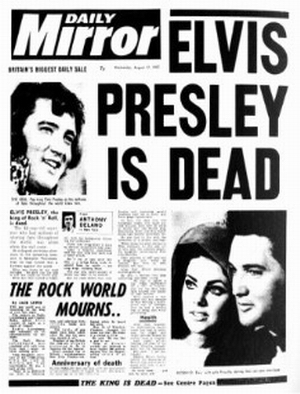



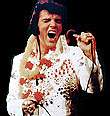
Back
 1935 - 1948
1935 - 1948 Elvis’
parents cannot afford a bicycle that Elvis wants, so Gladys talks him into
accepting a guitar instead. Elvis' first guitar costs $12.95 and is purchased at
the Tupelo Hardware Company. The bicycle would have to wait until Christmas of
1947.
Elvis’
parents cannot afford a bicycle that Elvis wants, so Gladys talks him into
accepting a guitar instead. Elvis' first guitar costs $12.95 and is purchased at
the Tupelo Hardware Company. The bicycle would have to wait until Christmas of
1947. 


 including
package tours of artists from the Hayride. Colonel Parker is involved.
This includes touring with Hank Snow. The regular Hayride appearances
continue. Drummer D.J. Fontana joins Elvis’ band. In the spring, Elvis fails to
be accepted on Arthur Godfrey’s Talent Scouts, a network television show.
As always, Elvis’ live appearances have special appeal for the teenagers,
especially the females. His unusual style, sexy moves, and good looks start to
cause more and more excitement wherever he plays. Sometimes the crowds break
through the barricades in near-riot behavior. Elvis gains more and more
popularity and begins to receive national attention. Colonel Parker becomes more
involved in Elvis’ career.
including
package tours of artists from the Hayride. Colonel Parker is involved.
This includes touring with Hank Snow. The regular Hayride appearances
continue. Drummer D.J. Fontana joins Elvis’ band. In the spring, Elvis fails to
be accepted on Arthur Godfrey’s Talent Scouts, a network television show.
As always, Elvis’ live appearances have special appeal for the teenagers,
especially the females. His unusual style, sexy moves, and good looks start to
cause more and more excitement wherever he plays. Sometimes the crowds break
through the barricades in near-riot behavior. Elvis gains more and more
popularity and begins to receive national attention. Colonel Parker becomes more
involved in Elvis’ career. 







 Elvis begins work on his third motion picture, Jailhouse Rock for
MGM.
Elvis begins work on his third motion picture, Jailhouse Rock for
MGM. 


 Its impressive list of co-stars and supporting cast includes Carolyn Jones,
Walter Matthau, Dean Jagger and Vic Morrow. It becomes a top five film at the
box office. This Michael (Casablanca) Curtiz-directed movie, set in New Orleans
and based upon the Harold Robbins novel, "A Stone for Danny Fisher," will come
to be regarded as Elvis’ finest film, his greatest acting performance, and proof
positive of his potential to have become a respected serious actor, though the
realization of this desire will remain forever out of his grasp.
Its impressive list of co-stars and supporting cast includes Carolyn Jones,
Walter Matthau, Dean Jagger and Vic Morrow. It becomes a top five film at the
box office. This Michael (Casablanca) Curtiz-directed movie, set in New Orleans
and based upon the Harold Robbins novel, "A Stone for Danny Fisher," will come
to be regarded as Elvis’ finest film, his greatest acting performance, and proof
positive of his potential to have become a respected serious actor, though the
realization of this desire will remain forever out of his grasp. 


 He
has served his country just like any other GI, with no special privileges his
celebrity status might have afforded him. These two years away from his career
have been a time to mature. He has also worried constantly that his lengthy
absence might have damaged his career progress. But, he has yet to see his
greatest stardom.
He
has served his country just like any other GI, with no special privileges his
celebrity status might have afforded him. These two years away from his career
have been a time to mature. He has also worried constantly that his lengthy
absence might have damaged his career progress. But, he has yet to see his
greatest stardom. 





 Elvis receives numerous official honors in appreciation for this benefit. This
turns out to be Elvis’ last live, non-movie performance until his 1968
television special.
Elvis receives numerous official honors in appreciation for this benefit. This
turns out to be Elvis’ last live, non-movie performance until his 1968
television special. 















 The sixties have brought about great change in music and pop culture.
Change for which Elvis helped pave the way over a decade earlier when he
exploded onto the scene with his unique blending of pop, rock, country, R&B and
gospel influences. Focusing on his Hollywood movie career in the sixties, Elvis
has become less a part of the current pop cultural scene. He has been making one
movie after another, and many of the records he has put out in these years have
been movie soundtrack albums. In the fifties and early sixties, the films and
film-related records were wonderfully successful, but as the sixties have worn
on, the movies and records, though still profitable, have not been nearly so
successful as they were before. Elvis has reached the supreme level of
frustration with the state of his career and all its limitations on his
creativity and artistic expression. He had hoped to become a serious actor, but
Hollywood had other ideas and Elvis went along with them. His opportunities to
show his true talents as an actor have been few. He is beyond ready for a
change. By now, it has been more than seven years since Elvis has appeared in
front of a live audience. Elvis has missed the closeness of his audience, the
energy and excitement of live performing.
The sixties have brought about great change in music and pop culture.
Change for which Elvis helped pave the way over a decade earlier when he
exploded onto the scene with his unique blending of pop, rock, country, R&B and
gospel influences. Focusing on his Hollywood movie career in the sixties, Elvis
has become less a part of the current pop cultural scene. He has been making one
movie after another, and many of the records he has put out in these years have
been movie soundtrack albums. In the fifties and early sixties, the films and
film-related records were wonderfully successful, but as the sixties have worn
on, the movies and records, though still profitable, have not been nearly so
successful as they were before. Elvis has reached the supreme level of
frustration with the state of his career and all its limitations on his
creativity and artistic expression. He had hoped to become a serious actor, but
Hollywood had other ideas and Elvis went along with them. His opportunities to
show his true talents as an actor have been few. He is beyond ready for a
change. By now, it has been more than seven years since Elvis has appeared in
front of a live audience. Elvis has missed the closeness of his audience, the
energy and excitement of live performing.  The '68 Special opens with Elvis singing a hot new version of the
gutsy "Trouble", from his 1958 film King Creole. This segues into
Guitar Man, which, with its semi-autobiographical lyrics, becomes the
underlying theme of the show. Then, Elvis is reunited with two of his original
fifties band members, guitarist Scotty Moore and drummer D.J. Fontana. (Bass
player Bill Black has been deceased for several years by this time.) They sit
together on stage in the round, along with several other friends and associates
of Elvis for an informal session of singing, jamming, and swapping stories.
Parts of this jam session are woven throughout the show. There are also
sequences of Elvis taking the stage alone and performing many of his greatest
hit rockers and ballads, and he introduces a new song, Memories.
The '68 Special opens with Elvis singing a hot new version of the
gutsy "Trouble", from his 1958 film King Creole. This segues into
Guitar Man, which, with its semi-autobiographical lyrics, becomes the
underlying theme of the show. Then, Elvis is reunited with two of his original
fifties band members, guitarist Scotty Moore and drummer D.J. Fontana. (Bass
player Bill Black has been deceased for several years by this time.) They sit
together on stage in the round, along with several other friends and associates
of Elvis for an informal session of singing, jamming, and swapping stories.
Parts of this jam session are woven throughout the show. There are also
sequences of Elvis taking the stage alone and performing many of his greatest
hit rockers and ballads, and he introduces a new song, Memories.

 In one of the jam session segments, Elvis speaks of the gospel origins of
rock and roll. This segues into the gospel music portion of the show, which has
Elvis wearing a two-piece burgundy suit, singing "Where Could I Go But to the
Lord," "Up Above My Head" and "I’m Saved," backed by the female vocal group, The
Blossoms, and accompanied by a troupe of dancers - all of this for a rousing
gospel production number.
In one of the jam session segments, Elvis speaks of the gospel origins of
rock and roll. This segues into the gospel music portion of the show, which has
Elvis wearing a two-piece burgundy suit, singing "Where Could I Go But to the
Lord," "Up Above My Head" and "I’m Saved," backed by the female vocal group, The
Blossoms, and accompanied by a troupe of dancers - all of this for a rousing
gospel production number.  Toward the end of the special Elvis appears in a lengthy production number
that, through song, dance, karate, and various situations, traces a young man’s
journey from a struggling guitar player, through the challenges, dangers and
compromises on the path to his dreams of success and superstardom. Something is
lost along the way. Once the dream is achieved, the man realizes that he remains
unfulfilled, that he has abandoned his true self. He decides to return to his
roots, doing what made him happiest, what he does best. He sings “I’ll never be
more than what I am... a swingin’ little guitar man.” The parallels to Elvis'
own life are clear and deliberate, and his doing the ‘68 special represents his
own return to his true self, to his roots. Free from the confines of his
Hollywood grind, this is Elvis the singer, the performer, the musician, the man
- the real Elvis.
Toward the end of the special Elvis appears in a lengthy production number
that, through song, dance, karate, and various situations, traces a young man’s
journey from a struggling guitar player, through the challenges, dangers and
compromises on the path to his dreams of success and superstardom. Something is
lost along the way. Once the dream is achieved, the man realizes that he remains
unfulfilled, that he has abandoned his true self. He decides to return to his
roots, doing what made him happiest, what he does best. He sings “I’ll never be
more than what I am... a swingin’ little guitar man.” The parallels to Elvis'
own life are clear and deliberate, and his doing the ‘68 special represents his
own return to his true self, to his roots. Free from the confines of his
Hollywood grind, this is Elvis the singer, the performer, the musician, the man
- the real Elvis.  At the end of the special, Elvis appears alone wearing a simple white
two-piece suit, standing in front of the towering backdrop of red lights that
spell ELVIS. He sings a brand new song, "If I Can Dream," especially written for
the show. The writers created the song based in part upon conversations with
Elvis about his own thoughts on what was happening in the turbulent sixties. It
seemed appropriate that he close the show with some sort of personal statement.
His powerful and passionate performance of this song of hope for mankind is one
of the most brilliant moments of his singing career.
At the end of the special, Elvis appears alone wearing a simple white
two-piece suit, standing in front of the towering backdrop of red lights that
spell ELVIS. He sings a brand new song, "If I Can Dream," especially written for
the show. The writers created the song based in part upon conversations with
Elvis about his own thoughts on what was happening in the turbulent sixties. It
seemed appropriate that he close the show with some sort of personal statement.
His powerful and passionate performance of this song of hope for mankind is one
of the most brilliant moments of his singing career. 



 This engagement breaks all existing Las Vegas attendance records and
attracts rave reviews from the public and the critics. It is a triumph. Elvis'
first live album, Elvis in Person at the International Hotel, Las Vegas,
Nevada, is recorded during this engagement and is soon released.
This engagement breaks all existing Las Vegas attendance records and
attracts rave reviews from the public and the critics. It is a triumph. Elvis'
first live album, Elvis in Person at the International Hotel, Las Vegas,
Nevada, is recorded during this engagement and is soon released.  Here are a couple of reviews from music writers:
Here are a couple of reviews from music writers: 






 Audience tickets for the January 14 concert and its January 12
pre-broadcast rehearsal show carry no price. Each audience member is asked to
pay whatever he or she can. The performances and concert merchandise sales are a
benefit raising $75,000 for the Kui Lee Cancer Fund in Hawaii. (Kui Lee was a
Hawaiian composer who had died of cancer while still in his thirties.)
Audience tickets for the January 14 concert and its January 12
pre-broadcast rehearsal show carry no price. Each audience member is asked to
pay whatever he or she can. The performances and concert merchandise sales are a
benefit raising $75,000 for the Kui Lee Cancer Fund in Hawaii. (Kui Lee was a
Hawaiian composer who had died of cancer while still in his thirties.)  In the special, Elvis' recording of the theme song from his 1965 movie
Paradise, Hawaiian Style plays over the opening credits and scenes of Elvis'
helicopter arrival at the airport and his walking among the fans who are there
to greet him. The concert opens with Elvis' band playing his traditional
introduction for his seventies concerts, Theme from 2001. He sings See, See
Rider, Burning Love, Something, You Gave Me a Mountain, Steamroller Blues, My
Way, Love Me, Johnny B. Goode, It’s Over, Blue Suede Shoes, I’m So Lonesome I
Could Cry, I Can’t Stop Loving You, Hound Dog, What Now, My Love, Fever, Welcome
to My World, Suspicious Minds, I’ll Remember You (A Kui Lee composition Elvis
sings after announcing the sum raised for the Kui Lee Cancer Fund.), Long Tall
Sally/Whole Lotta Shakin’ Goin’ On, An American Trilogy (Elvis tosses his belt
into the audience), A Big Hunk o’ Love, and Can’t Help Falling in Love (Elvis
tosses his cape into the audience). The show is one hour, including commercials.
After the show, Elvis and his bandmates come back out on stage in the empty
arena and videotape performances of the songs Blue Hawaii, Ku-u-i-po, and
Hawaiian Wedding Song which he had first done for his 1961 hit movie, Blue
Hawaii, plus Early Morning Rain and No More. All but the song No More will be
inserted into the American broadcast with Elvis seen on a montage screen with
footage of Hawaiian scenery.
In the special, Elvis' recording of the theme song from his 1965 movie
Paradise, Hawaiian Style plays over the opening credits and scenes of Elvis'
helicopter arrival at the airport and his walking among the fans who are there
to greet him. The concert opens with Elvis' band playing his traditional
introduction for his seventies concerts, Theme from 2001. He sings See, See
Rider, Burning Love, Something, You Gave Me a Mountain, Steamroller Blues, My
Way, Love Me, Johnny B. Goode, It’s Over, Blue Suede Shoes, I’m So Lonesome I
Could Cry, I Can’t Stop Loving You, Hound Dog, What Now, My Love, Fever, Welcome
to My World, Suspicious Minds, I’ll Remember You (A Kui Lee composition Elvis
sings after announcing the sum raised for the Kui Lee Cancer Fund.), Long Tall
Sally/Whole Lotta Shakin’ Goin’ On, An American Trilogy (Elvis tosses his belt
into the audience), A Big Hunk o’ Love, and Can’t Help Falling in Love (Elvis
tosses his cape into the audience). The show is one hour, including commercials.
After the show, Elvis and his bandmates come back out on stage in the empty
arena and videotape performances of the songs Blue Hawaii, Ku-u-i-po, and
Hawaiian Wedding Song which he had first done for his 1961 hit movie, Blue
Hawaii, plus Early Morning Rain and No More. All but the song No More will be
inserted into the American broadcast with Elvis seen on a montage screen with
footage of Hawaiian scenery.  A Little History on Elvis' Costume: Elvis told Bill Belew he wanted the
jumpsuit for this special to say “America” to the worldwide viewing audience.
Bill told Elvis that, except for the American flag, he could think of nothing
other than the American Eagle. Elvis said “I like it.” And that’s how one of
Elvis' most famous costumes came to be. Elvis had been wearing jumpsuits on
stage since 1970, and they had become quite elaborate by the time of this show.
For the past year or two he had been wearing studded, hip-length capes and heavy
studded leather belts with his jumpsuits. For the American Eagle jumpsuit, Bill
first designed a huge calf-length cape. During preparations for the show, Elvis
tried working with this cape, but it was just too cumbersome to use. So, out
went the emergency order for another cape in the usual size.
A Little History on Elvis' Costume: Elvis told Bill Belew he wanted the
jumpsuit for this special to say “America” to the worldwide viewing audience.
Bill told Elvis that, except for the American flag, he could think of nothing
other than the American Eagle. Elvis said “I like it.” And that’s how one of
Elvis' most famous costumes came to be. Elvis had been wearing jumpsuits on
stage since 1970, and they had become quite elaborate by the time of this show.
For the past year or two he had been wearing studded, hip-length capes and heavy
studded leather belts with his jumpsuits. For the American Eagle jumpsuit, Bill
first designed a huge calf-length cape. During preparations for the show, Elvis
tried working with this cape, but it was just too cumbersome to use. So, out
went the emergency order for another cape in the usual size. 



